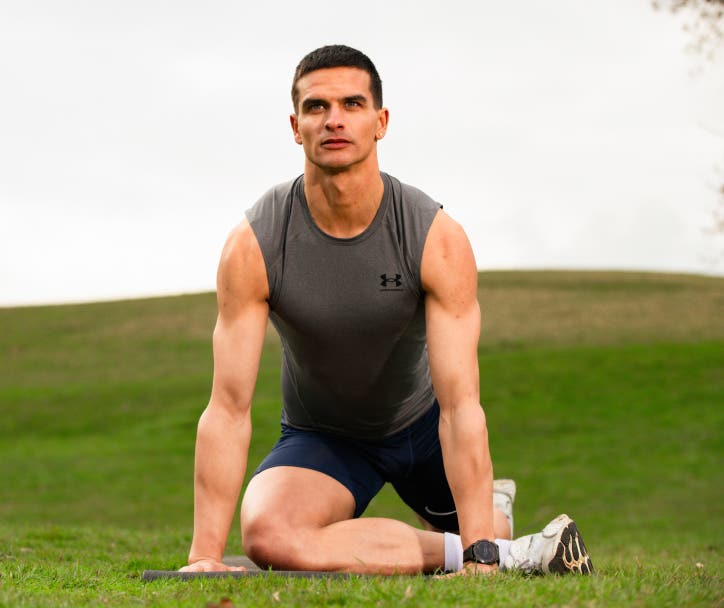Whether you call it football or soccer, it’s a dynamic sport that demands physical fitness, technical skill, and mental acuity.
And while each position on the field has specific requirements, certain training principles apply universally. Whether you're an aspiring professional or a weekend warrior, understanding these principles can help you train effectively and boost your performance.
Endurance training
Endurance is a cornerstone of football fitness. Players need to sustain high levels of activity throughout the 90-minute (or longer) match. This involves continuous movement, short sprints, and rapid recovery.
Football players benefit from two main types of endurance training: long-distance running and interval training. But before we get into each, let’s cover the basics of your body’s energy systems at play here.
Energy systems
Of the body’s three main energy systems, soccer taps into two different ones during a match.
The aerobic system is the body's primary source of energy during sustained, lower-intensity activities. This system uses oxygen to convert carbohydrates, fats, and, to a lesser extent, proteins into energy.1 In football, the aerobic system is predominantly used during the following scenarios:
- Continuous running: Players often cover distances of 10-13 kilometers in a match, which involves a lot of jogging and low-intensity running.
- Positioning and movement: During periods when players are positioning themselves on the field or moving at a steady pace without high bursts of speed.
- Recovery periods: In between sprints or high-intensity efforts, the aerobic system helps in recovery by replenishing energy stores and clearing lactate from the muscles.
The anaerobic system kicks in during high-intensity activities that require quick bursts of energy. This system operates without the need for oxygen and uses stored energy in the muscles (in the form of glycogen) to produce ATP (adenosine triphosphate), the energy currency of cells. In football, the anaerobic system is critical during:
- Sprints: Short bursts of speed to chase down a ball, make a run, or recover defensively.
- Explosive movements: Quick changes in direction, jumping to head the ball, and powerful shots at the goal.
- High-intensity play: Periods of intense activity, such as pressing the opposition, rapid transitions between attack and defense, and tackling.
Now that we’ve covered how your energy is used during a match, let’s dive into what types of training will best prepare you for your time on the pitch.
Long-distance running: Long-distance running at a steady, easy pace helps boost cardiovascular fitness and improves the body’s efficiency in transporting and using oxygen. This type of training enhances stamina, allowing players to maintain a high level of performance throughout the game.
Interval training: Football matches involve frequent bursts of high-intensity activity followed by periods of lower intensity. Interval training mimics these demands by alternating between high-intensity sprints and lower-intensity recovery periods. This method trains the body to recover quickly and improves both aerobic and anaerobic capacities.

Strength training
Strength training is the real MVP for footballers. Not only does it deliver a boost of overall power, but it also helps prevent injuries and improve skill execution. And a balanced strength training program is where the magic happens – targeting your core, legs, and upper body with both weighted and bodyweight exercises.2
Core: Exercises such as Situps, Twists, and Planks are essential for core strength. A strong core is key for stability, balance, and power transfer moves like shooting, passing, and tackling.
Legs: Squats, Lunges, and Calf Raises are fundamental for building strong legs. And powerful legs translate to explosive speed, agility, and the ability to conquer the field.
Upper body: Football relies heavily on lower-body strength, but don’t sideline the upper body. Exercises like Pushups, Pullups, and Bench Press can bolster your upper-body strength which can help with shielding the ball, balance, and overall physical presence on the field.

Speed and agility
Speed and agility enable you to outpace rivals, swiftly change direction, and react decisively to on-field challenges.
Speed: Short sprints, hill sprints, and plyometric exercises are effective ways to develop speed. These activities train the fast-twitch muscle fibers, enhancing explosive power and acceleration.
Agility: Cone drills and reaction drills are excellent for improving agility. These exercises simulate the quick changes of direction and rapid decision-making required during a match.
Flexibility and recovery
Flexibility and recovery are often underestimated but are crucial to bringing your A-game on the pitch and keeping those injuries at bay.
Warmup and cooldown: Proper Warmups prepare your body (and mind!) for what's to come and help reduce the risk of injury. Cooldowns aid in the recovery process, helping to prevent stiffness and muscle soreness.
Stretching: Regular stretching improves flexibility, which enhances overall movement efficiency and reduces injury risk. Incorporate static and dynamic stretching into your routine to tap into all those juicy benefits.
Active recovery: Active recovery, such as easy jogging, cycling, or hitting your base, helps flush out metabolic waste products and speeds up the recovery process after intense training sessions or matches.

The mental aspect
The mental aspect of soccer is just as important as the physical. And this couldn’t ring more true, as seen in the widespread use of sports psychologists by professional teams and athletes today.
The mind-body connection is powerful and shouldn’t be overlooked. While psychologists are a great option if you have access to one, there are also key strategies you can implement yourself to sharpen your mind and boost overall performance:
Positive self-talk: Positive self-talk can boost confidence and focus. Staying positive and self-encouraging during training and matches can help you conquer challenges and maintain a resilient mindset.3
Self-confidence: Believing in your abilities can enhance performance and decision-making under pressure.
Visualization: Visualization involves mentally rehearsing plays and successful outcomes. This technique helps improve focus, prepares you for different scenarios, and boosts overall performance. Don’t let any part of the game catch you off guard.
Let’s recap
Training like a footballer is multifaceted. It’s all about endurance, strength, speed, agility, flexibility, and a whole lot of grit.
Here are the key takeaways:
- Endurance training: Incorporate long-distance running and interval training to build both aerobic and anaerobic capacities.
- Strength training: Focus on core, leg, and upper body exercises to enhance overall power and reduce injury risk.
- Speed and agility: Use sprints, hill sprints, plyometrics, and agility drills to develop explosive power and quick directional changes.
- Flexibility and recovery: Prioritize proper Warmups, Cooldowns, stretching, and active recovery to maintain peak performance and prevent injuries.
- Mental training: Practice positive self-talk, build self-confidence, and use visualization techniques to enhance mental toughness.
By incorporating these training strategies into your routine, you’ll train like a football (or soccer) pro and excel on the field.
Sources
[1] Bangsbo, J., Mohr, M., & Krustrup, P. (2006). Physical and metabolic demands of training and match-play in the elite football player. Journal of Sports Sciences, 24(7), 665-674. doi:10.1080/02640410500482529
[2] Lehance, C., Binet, J., Bury, T., & Croisier, J. L. (2009). Muscular strength, functional performances and injury risk in professional and junior elite soccer players. Scandinavian Journal of Medicine & Science in Sports, 19(2), 243-251. doi:10.1111/j.1600-0838.2008.00780.x
[3] Thelwell, R. C., Greenlees, I. A., & Weston, N. J. V. (2006). Examining the use of psychological skills throughout soccer performance. Journal of Sport Behavior, 29(3), 299-314.